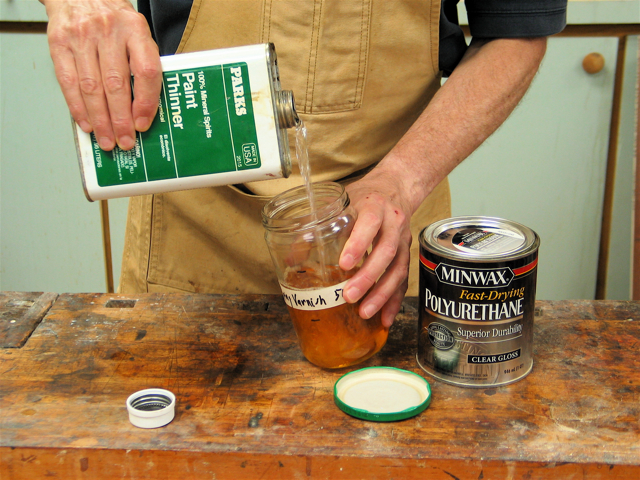We may receive a commission when you use our affiliate links. However, this does not impact our recommendations.
You often see cans of solvent finishes, including lacquer, and alkyd and polyurethane varnish, with instructions not to thin them. Manufacturers include these instructions in order to comply with VOC laws in some areas of the country, such as California. Adding thinner could take the finish out of compliance with the local or state laws, and manufacturers might be breaking the law if they advocated thinning.
But they then sell these finishes everywhere so they can avoid printing a separate label. It’s most likely that you live somewhere that these restrictions don’t apply.
The instruction can be confusing, however. It may lead you to think that you might be doing some harm to the finish if you thin it. Just to be clear, you can’t do any harm to any finish by adding thinner. In fact, you can add all the thinner you want to solvent finishes, even 99 percent, without causing any harm. You’ll just get a thinner build with each coat, which may result in your having to apply more coats to get the look and protection against liquids that you want.
The advantage of adding thinner (five to thirty percent is usually adequate) is better leveling – that is, reduced brush marking and orange peel.
Keep in mind, however, that if you are in an area of the country with strict VOC laws, you could be taking the finish out of compliance if you add thinner.
— Bob Flexner
Editor’s note – You’ll find all of Bob’s books in our store: “Flexner on Finishing” and “Wood Finishing 101.”
Here are some supplies and tools we find essential in our everyday work around the shop. We may receive a commission from sales referred by our links; however, we have carefully selected these products for their usefulness and quality.










On a recent project I sprayed un-thinned lacquer, but got some orange-peel. I felt i was using enough finish so I added some retarder (5% as recommended by the manufacturer). Orange peel was reduced and after a week I started rubbing out the finish. The finish is soft and easy to scratch…a finger nail will do it. Did I use too much retarder? Will the finish harden if I wait? Anyone ideas on what I can do?
The way I look at is, when I buy it, it is mine and I can what I want to it. I don’t think there is any VOC police.
I also want to understand what really constitutes “thinner” for the various finishes. Alcohol thins shellac, but I have heard from a shellac provider that it should be the only ethanol and the alcohol in most big box stores alcohols have many other solvents in them as well. Lacquer should use lacquer thinner, but here in California real,simple lacquer thinner is no longer available. What do we look for? Do all varnishes use paint thinner as a thinner, and are all those suitable thinners? And then there is the other question water based products. Tap water? Distilled water only? “Thinner” is a really misleading term as there a so many formulations. The worry is that they are not all compatible for thinning as much as they are for clean-up of the various finishes.
Very diplomatic way to put it. ” Adding thinner could take the finish out of compliance with the local or state laws, and manufacturers might be breaking the law if they advocated thinning.”
How do they get around the VOC for wiping varnish, which is more highly thinned by mfr., just put it in smaller cans?
I was shocked last year when I found out I could not buy Waterlox in gallons, only quarts. But my buddy is 12 miles away in a neighboring state, he could buy it or have it shipped to him (from my state, where it’s made).
Always enjoy your articles, Bob.
I assume the same advice holds true for water-based finishes?